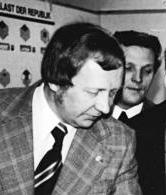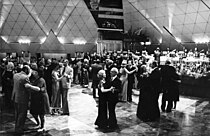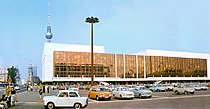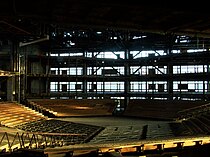
East Germany, officially known as the German Democratic Republic, was a country in Central Europe from its formation on 7 October 1949 until its reunification with West Germany on 3 October 1990. Until 1989, it was generally viewed as a communist state and described itself as a socialist "workers' and peasants' state". The economy of the country was centrally planned and state-owned. Although the GDR had to pay substantial war reparations to the Soviets, its economy became the most successful in the Eastern Bloc.

The Party of Democratic Socialism was a left-wing populist political party in Germany active between 1989 and 2007. It was the legal successor to the communist Socialist Unity Party of Germany (SED), which ruled the German Democratic Republic as the sole governing party until 1990. From 1990 through to 2005, the PDS had been seen as the left-wing "party of the East". While it achieved minimal support in western Germany, it regularly won 15% to 25% of the vote in the eastern new states of Germany, entering coalition governments with the Social Democratic Party of Germany in the federal states of Mecklenburg-Vorpommern and Berlin.

Erich Ernst Paul Honecker was a German communist politician who led the German Democratic Republic from 1971 until shortly before the fall of the Berlin Wall in November 1989. He held the posts of General Secretary of the Socialist Unity Party of Germany (SED) and Chairman of the National Defence Council; in 1976, he replaced Willi Stoph as Chairman of the State Council, the official head of state. As the leader of East Germany, Honecker was viewed as a dictator. During his leadership, the country had close ties to the Soviet Union, which maintained a large army in the country.

Erich Fritz Emil Mielke was a German communist official who served as head of the East German Ministry for State Security, better known as the Stasi, from 1957 until shortly after the fall of the Berlin Wall in 1989. Dubbed "The Master of Fear" by the West German press, Mielke was one of the most powerful and most hated men in East Germany.

The Volkskammer was the supreme power organ of East Germany. It was the only branch of government in the state, and per the principle of unified power, all state organs were subservient to it.

Hans Modrow was a German politician best known as the last communist premier of East Germany.
Articles related to East Germany include:

Wilhelm Stoph was a German politician. He served as Chairman of the Council of Ministers of the German Democratic Republic from 1964 to 1973, and again from 1976 until 1989. He also served as chairman of the State Council from 1973 to 1976.

The Berlin Palace, formally the Royal Palace and also known as the City Palace, is a large building adjacent to Berlin Cathedral and the Museum Island in the Mitte area of Berlin. It was the main residence of the House of Hohenzollern from 1443 to 1918. Expanded by order of Frederick I of Prussia according to plans by Andreas Schlüter from 1689 to 1713, it was thereafter considered a major work of Prussian Baroque architecture. The royal palace became one of Berlin’s largest buildings and shaped the cityscape with its 60-meter-high (200 ft) dome erected in 1845.

Schloßplatz is a square located on Museum Island (Museumsinsel) in Berlin, Germany. It measures about 225 m by 175 m, with its long side oriented on an axis approximately southwest/northeast. At its west corner is the Schlossbrücke, from which Unter den Linden leads west to the Brandenburg Gate. From the same corner, Karl-Liebknecht-Straße runs northeast alongside the square and on to Alexanderplatz. Until the early 20th century, only the square south of the palace was so named, the square north of it being the Lustgarten.

The Peaceful Revolution – also, in German called Die Wende – was one of the peaceful revolutions of 1989 at the peak of the collapse of the Eastern Bloc in the late 1980s. A process of sociopolitical change that led to, among other openings, the opening of their borders to the Western world.

The national emblem of East Germany featured a hammer and a compass, surrounded by a ring of wheat. It was an example of what has been called "socialist heraldry". It was the only heraldic device of a European socialist state with a ring of grain which does not contain a red star.

Margot Honecker was an East German politician and influential member of the country's Communist government until 1989. From 1963 until 1989, she was Minister of National Education of the German Democratic Republic (GDR). She was married to Erich Honecker, leader of East Germany's ruling Socialist Unity Party from 1971 to 1989 and concurrently from 1976 to 1989 the country's head of state.

The Communist Party of Germany is a Marxist-Leninist communist party in Germany. It is one of several parties which claim the KPD name and/or legacy. It was founded in Berlin in 1990. The party is also commonly referred to by the name KPD-Ost to differentiate it from other parties with the same name, most prominently the historical Communist Party of Germany.

Karl-Liebknecht-Straße is a major street in the central Mitte district of the German capital Berlin. It is named after Karl Liebknecht (1871–1919), one of the founders of the Communist Party of Germany. The street connects the Unter den Linden boulevard with the Prenzlauer Allee arterial road leading to the northern city limits. Although part of the street dates back to medieval times, most of the buildings at its side were built in the 1960s, when East Berlin's centre was redesigned as the capital of East Germany.

"Sonderzug nach Pankow" is a song by the German rock singer Udo Lindenberg, released as a single on 2 February 1983. It was a reaction to the refusal of the West German singer's wish to perform a concert in East Germany by the East German administration in charge. The song's lyrics refer directly to East German leader Erich Honecker, who took offense to the song. The melody is based on the 1941 swing classic "Chattanooga Choo Choo" by Glenn Miller.
Zersetzung was a psychological warfare technique used by the Ministry for State Security (Stasi) to repress political opponents in East Germany during the 1970s and 1980s. Zersetzung served to combat alleged and actual dissidents through covert means, using secret methods of abusive control and psychological manipulation to prevent anti-government activities. People were commonly targeted on a pre-emptive and preventive basis, to limit or stop activities of dissent that they may have gone on to perform, and not on the basis of crimes they had actually committed. Zersetzung methods were designed to break down, undermine, and paralyze people behind "a facade of social normality" in a form of "silent repression".

Heinz Graffunder was a German architect.

Hero of the German Democratic Republic (GDR) was an honorific title awarded by the former East German state, accompanied by a certificate and medal. The title was instituted by the politburo of the Socialist Unity Party on 29 October 1975 as the most prestigious award of the GDR and first awarded on 28 November 1975. In total, it was awarded on 17 occasions to 11 recipients.

Wolfgang Junker was a German construction manager, civil servant and politician of the Socialist Unity Party (SED).




























